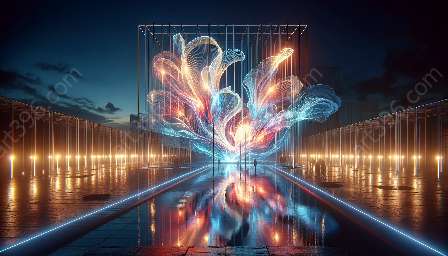Light art is a fascinating medium that can elicit powerful emotions and memories through the use of color. In this article, we will explore the intricate relationship between color, nostalgia, and memories within the realm of light art.
The Influence of Color in Light Art
Color is a fundamental element in light art, capable of influencing perceptions, emotions, and memories. It serves as a visual language that communicates and evokes different moods and feelings. The choice of color can greatly impact the overall experience and interpretation of a light art installation.
Psychological Impact of Color
Colors have the ability to trigger emotional and nostalgic responses. Certain colors can evoke specific memories due to their association with past experiences, environments, or cultural connotations. For example, warm tones like golden yellows and deep oranges can evoke feelings of nostalgia and warmth, reminiscent of a sunset or a cozy fireplace.
Nostalgia and Memories
Color has the power to transport viewers back in time, triggering memories and emotions from the past. It can recreate the ambiance of a particular era or spark associations with personal experiences. For instance, the use of vibrant neon colors may evoke memories of 80s pop culture and urban nightlife, creating a sense of nostalgia for that time period.
Sensory Experience
Light art engages the senses, and color plays a pivotal role in shaping the sensory experience. By combining different hues, intensities, and contrasts, artists can craft immersive environments that resonate with viewers on an emotional and nostalgic level. The interplay of colors can mimic natural phenomena or create surreal, dreamlike atmospheres, leading the audience on a journey through time and memory.
Interactivity and Engagement
Interactive light art installations often utilize color to prompt viewer engagement and participation. Colors can be dynamically altered based on audience interactions, allowing for a personalized and evocative experience. This interactivity can trigger memories and emotional responses unique to each individual, further enhancing the nostalgic and memorable aspects of the artwork.
Memory and Perception
Color has a profound impact on how memories are formed and perceived. Studies have shown that color can influence memory retention and the emotional intensity of recollections. In the context of light art, the strategic use of color can tap into the viewer's memory bank, eliciting a cascade of associative memories and emotions.
Symbolism and Cultural References
Colors carry symbolic meanings and cultural references that can contribute to the evocation of nostalgia and memories in light art. Certain colors are deeply ingrained in cultural traditions and historical contexts, triggering collective memories and resonating with shared experiences. By leveraging these cultural references, artists can imbue their light art with layers of nostalgia and historical significance.
Conclusion
Color is a powerful tool in the realm of light art, capable of evoking nostalgia and memories in profound ways. Through its psychological, sensory, and cultural impact, color enriches the viewer's experience, creating an emotional and memorable journey through time and nostalgia in the context of light art.

